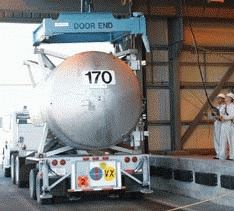Depot destroys last of VX rockets
Published 2:23 pm Friday, January 25, 2008

- The last load of VX rockets are unloaded from the Umatilla Chemical Depot storage area on Jan. 18.
By The Hermiston Herald
HERMISTON The last of the M55 VX nerve agent rockets were destroyed on Wednesday, ending another piece of the VX campaign at the Umatilla Chemical Agent Disposal Facility.
There were 14,519 M55 VX nerve agent rockets and warheads to be destroyed when the start of the VX campaign began late October of last year. The VX rockets also were the last of a total of 105,961 VX-filled and GB (sarin)-filled rockets destroyed in Oregon, and the last self-propelled chemical munitions in the Umatilla Chemical Depot (UMCD) stockpile.
“This is a true team accomplishment,” said Don Barclay, site project manager for the Army. “The Army and its contractors worked many years to reduce the risk of chemical munitions and reach this important milestone. Our community is just that much safer now.”
Chemical munitions remaining in the Oregon stockpile include VX artillery projectiles, VX land mines, and mustard agent ton containers. Some of these munitions contain explosives as well as agent, but none of them contain propellant motors as rockets did. M55 rockets were capable of flying up to six miles if launched. They were never used by American troops in combat.
“The most important accomplishment was to reach this milestone safely and in compliance with all environmental requirements,” said Doug Hamrick, project general manager for URS Washington Division, the company that built and operates the disposal plant for the Army.
The VX rocket disposal campaign began on Oct. 26, 2007, when rockets were first moved from the depot storage area to the disposal plant. The first VX rocket was safely destroyed on Oct. 29, 2007. The last VX rockets were moved from depot storage to the disposal plant on Friday, Jan. 18. In addition, a simultaneous campaign to dispose of the last VX aircraft spray tanks in the Umatilla and national stockpile began on Nov. 23, 2007 and was completed on Dec. 24, 2007.
Rockets and spray tanks comprised 49 percent of the VX nerve agent stockpile tonnage at Umatilla. In addition, a single VX ton container from a mid-1980s “drill and transfer” campaign to eliminate leaking munitions was destroyed on Nov. 26.
“I’m proud of our dedicated storage workers, who have safely moved more than 170 thousand munitions to the disposal plant without incident or accident,” said Lt. Col. Bob Stein, depot commander.
The UMCDF will now perform a “changeover” to process 155mm VX artillery projectiles. This involves changing equipment to handle different-size munitions, reviewing procedures, and providing refresher training for workers. The plant previously processed GB or sarin-filled artillery projectiles, and that same equipment will be used again during the VX projectiles campaign. The changeover to prepare for VX projectiles processing is expected to take about two months.
VX nerve agent is a rapid-acting, lethal agent that affects the nervous system by interfering with the signals sent from the brain to vital organs and other parts of the body. It’s an odorless, clear and oily liquid.
Depot storage and disposal workers have safely accomplished several other key milestones during the past four years. The disposal plant started destroying M55 GB (sarin-filled) rockets on Sept. 8, 2004. Destruction of the last of 91,442 of those GB rockets was completed on Aug. 9, 2006. Simultaneous with the GB rockets disposal campaign, the plant began destroying 2,418 GB-filled 750-pound bombs on Sept. 27, 2005 and completed that campaign on June 9, 2006. Workers also destroyed 27 GB-filled 500-pound bombs during May 15-18, 2006. These bombs were the last chemical bombs of any type in the Umatilla and national weapons stockpile.
Overall, the Umatilla storage and disposal team will eventually transport and destroy munitions containing three types of chemical agent. The GB (sarin) nerve agent campaign is complete. The VX nerve agent disposal campaign that started in October 2006 is planned to be completed by spring of 2009. The final campaign will be to dispose of mustard blister agent, also known as HD, stored in bulk containers commonly referred to as “ton containers.”
After the last chemical munition is destroyed, the disposal plant will be disassembled during a three-year closure effort. According to the 2005 Base Realignment and Closure Act (BRAC), the entire depot will also eventually be closed when the chemical munitions storage and disposal mission is complete and all closure requirements are met.
Chemical munitions have been stored at the depot since the 1960s. They served as a Cold War deterrent, but are now aging, obsolete, and prone to leaking. They are kept in highly secure storage “igloos” as they await destruction.





